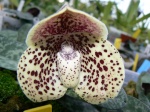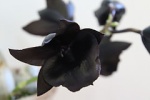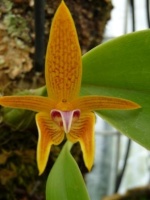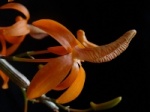Paphiopedilum Mount Toro x wilhelminae
+14
Lotoise
Fab
mb24
macaroni
Le Pape
eorchids
aurelien 81
domi28
Foldenatur
Mexivillo
Baptistonia
Loulou59
paul72
jean-ber
18 participants
Forum Orchidées : Tout un monde à découvrir :: Orchidées en fleurs :: Galerie de vos Orchidées en fleurs et Orchidées in situ :: Paphiopedilum, Phragmipedium, Mexipedium, Selenipedium :: Paphiopedilum hybrides
Page 2 sur 2
Page 2 sur 2 •  1, 2
1, 2
 Re: Paphiopedilum Mount Toro x wilhelminae
Re: Paphiopedilum Mount Toro x wilhelminae
Les étiquettes des vendeurs ..... 
Si j'en crois Cribb, il n'existerait que glanduliferum et wilhelminae, cela réduit de beaucoup le champ des investigations.

Si j'en crois Cribb, il n'existerait que glanduliferum et wilhelminae, cela réduit de beaucoup le champ des investigations.

______________________________________________________________________________________________________________________________
La philosophie nous enseigne à douter de ce qui nous paraît évident. La propagande, au contraire, nous enseigne à accepter pour évident ce dont il serait raisonnable de douter. A. Huxley

Lotoise- Administrateur
-
 Messages : 37181
Messages : 37181
Date d'inscription : 17/12/2012
Localisation : Sud Ouest/Aquitaine/47
 Re: Paphiopedilum Mount Toro x wilhelminae
Re: Paphiopedilum Mount Toro x wilhelminae
Praestans semble être revenu en grâce en 2012.
Il faut peut-être lire ceci : Koopowitz, H. (2012). An updated, annotated checklist of the genus Paphiopedilum. Orchid Digest 76: 178-215.
Il faut peut-être lire ceci : Koopowitz, H. (2012). An updated, annotated checklist of the genus Paphiopedilum. Orchid Digest 76: 178-215.
______________________________________________________________________________________________________________________________
Eric, frappé par la foudre orchidophile en 1980.
 Re: Paphiopedilum Mount Toro x wilhelminae
Re: Paphiopedilum Mount Toro x wilhelminae
Ce serait bien s'ils se mettaient d'accord, mais on ne peut pas trop demander aux botanistes ... 

______________________________________________________________________________________________________________________________
La philosophie nous enseigne à douter de ce qui nous paraît évident. La propagande, au contraire, nous enseigne à accepter pour évident ce dont il serait raisonnable de douter. A. Huxley

Lotoise- Administrateur
-
 Messages : 37181
Messages : 37181
Date d'inscription : 17/12/2012
Localisation : Sud Ouest/Aquitaine/47
 Re: Paphiopedilum Mount Toro x wilhelminae
Re: Paphiopedilum Mount Toro x wilhelminae
Prenons le problème à l'envers.
Avec quoi est hybride le Mount Toro pour avoir un Toro olé ?
Avec quoi est hybride le Mount Toro pour avoir un Toro olé ?
______________________________________________________________________________________________________________________________
Culture en appartement sous éclairage artificiel (HQI et T5)

macaroni-
 Messages : 541
Messages : 541
Date d'inscription : 12/10/2014
Age : 53
Localisation : VAL DE MARNE
 Re: Paphiopedilum Mount Toro x wilhelminae
Re: Paphiopedilum Mount Toro x wilhelminae
______________________________________________________________________________________________________________________________
Les Accros du jardin - Mon jardin en 2024: Juin - Juillet


Cloodie-
 Messages : 7914
Messages : 7914
Date d'inscription : 21/01/2013
Localisation : Montréal, Québec
 Re: Paphiopedilum Mount Toro x wilhelminae
Re: Paphiopedilum Mount Toro x wilhelminae
______________________________________________________________________________________________________________________________
Culture en appartement sous éclairage artificiel (HQI et T5)

macaroni-
 Messages : 541
Messages : 541
Date d'inscription : 12/10/2014
Age : 53
Localisation : VAL DE MARNE
 Re: Paphiopedilum Mount Toro x wilhelminae
Re: Paphiopedilum Mount Toro x wilhelminae
Et pourquoi ?macaroni a écrit:Oui merci ça je sais.
Mais je doute que ce soit avec un glanduliferum pour un hybride enregistré en 2004.
Paphiopedilum glanduliferum (Blume) Stein, Orchid.-Buch: 468 (1892).
Et le nom a été accepté en... tadam tadadam...
This name is Accepted by:
Govaerts, R. (2003). World Checklist of Monocotyledons Database in ACCESS: 1-71827. The Board of Trustees of the Royal Botanic Gardens, Kew.
C'est avant 2004, non ?
Pour prendre le problème à l'envers, il faudrait avoir commencé à l'endroit !

Après, je ne dis pas que ce n'est pas un Toro Ole, je n'y connais rien.

______________________________________________________________________________________________________________________________
Eric, frappé par la foudre orchidophile en 1980.
 Re: Paphiopedilum Mount Toro x wilhelminae
Re: Paphiopedilum Mount Toro x wilhelminae
Parce que si j'ai bien suivi le glanduliferum n'a pas été vue depuis mathusalem
______________________________________________________________________________________________________________________________
Culture en appartement sous éclairage artificiel (HQI et T5)

macaroni-
 Messages : 541
Messages : 541
Date d'inscription : 12/10/2014
Age : 53
Localisation : VAL DE MARNE
 Re: Paphiopedilum Mount Toro x wilhelminae
Re: Paphiopedilum Mount Toro x wilhelminae
Absolument, même jamais revu depuis qu'il a été décrit.macaroni a écrit:Parce que si j'ai bien suivi le glanduliferum n'a pas été vue depuis mathusalem

Voici ce que j'ai trouvé écrit par Guido Braem :
Paph. glanduliferum is an entity only known from the publication by Blume. That publication shows a detailed drawing of the staminode ... and there is NO known plant that has a staminode that corresponds with the staminode drawn by Blume. Thus, no-one really knows what Paph. glanduliferum is or was or whatever.
I made that clear in Braem, Baker & Baker, vol. 1 (pages 139-140) and again in Braem & Chiron (2003) (pages 364-365) ... where I wrote:
"This species is known only from the type material and the description and illustration in Blume's Rumphia and there is widespread disagreement about its correct classification. Unfortunately, although the description rendered by Blume (loc. cit.) is relatively extensive and quite detailed (see beloe) it causes confusion because there are no plants that quite answer to that description."
If you wish to know why Cribb argues differently, you will have to ask Cribb. For me, the only scientifically valid answer to the question "what is P. glanduliferum?" is "I don't know."
Un vrai sac de nœuds cette section.

______________________________________________________________________________________________________________________________
Eric, frappé par la foudre orchidophile en 1980.
 Re: Paphiopedilum Mount Toro x wilhelminae
Re: Paphiopedilum Mount Toro x wilhelminae
Après, tu as cet article de Leslie Garay (celui qui avait pondu le Phalaenopsis tetraspis var. speciosa il y a quelques années pour nous faire avaler les tetraspis C#1...  ). Lui, (1) conserve Paphiopedilum gardineri et (2) a vu des glanduliferum.
). Lui, (1) conserve Paphiopedilum gardineri et (2) a vu des glanduliferum.
Il est à la retraite, il aurait peut-être du ne pas en sortir !
A lire sur cette page pour voir les photos et les dessins.
 ). Lui, (1) conserve Paphiopedilum gardineri et (2) a vu des glanduliferum.
). Lui, (1) conserve Paphiopedilum gardineri et (2) a vu des glanduliferum.Il est à la retraite, il aurait peut-être du ne pas en sortir !

A lire sur cette page pour voir les photos et les dessins.
A REVIEW OF THE PAPHIOPEDILUM PRAESTANS COMPLEX, Leslie A. Garay, Ph. D.
Dr. Garay is a retired as director of the Oakes Ames Orchid Library and Herbarium of Harvard University. He is a world authority on orchid taxonomy and has written for many publications. Dr. Garay currently lives in Virginia.
During the past twenty years the volumes of the Orchid Digest have been a primary source of important information as well as documentations on a large number of Paphiopedilum species for all orchidophiles, professional and amateur alike. Because the various papers presented the individual species then of interest in a random manner, teir important contributions are treated rather casually and some even overlooked completely by current monographers.
Recently, through the courtesy of Mrs. Ralph Levy from Memphis, Tennessee, I had the opportunity to examine a number of living specimens of the Paphiopedilum praestans relationship. In consulting my records of types, as well as the prolific literature on this subject, I became rather concerned about the confusion that now surrounds the identity of each component species. Perhaps I became even more concerned about the steps that were proposed to perpetuate this existing confusion for orchid growers. In an attempt to clarify the confusion I prepared some notes on this subject for the Papua New Guinea Orchid News hoping to stimulate local interest in further field observations. This review here is based on these notes. In the following paragraphs attention is called to those salient features by which each species can be identified readily by both botanists and orchid growers alike, focusing particularly on the diagnostic value of the structure of the staminodes and their surfaces.
Unfortunately in one of the recent monographic studies of the genus Paphiopedilum a rather strong statement was made, namely that the shape of the staminode in this complex "is variable and that the differences in the staminode shape between the types are not taxonomically significant" (Cribb, 1987. This statement, however, is correct only if all component species of this complex are united under a single name.
In examining the fine details of each staminode in this complex they clearly fall into two distinct groups: 1. The naked, rugose central part of each staminode is linear-oblong and, 2. The naked, rugose central part of each staminode is trapezoid and shield-like, i.e., much broader at the tip of the staminode that at its base. Both types demonstrate certain variations, but no intermediates are known to occur.
Focusing on these initial and simple primary differences as they correlate with additional characters, the following distinct species can be recognized with certainty.
PAPHIOPEDILUM GLANDULIFERUM (Bl.) Stein
This is the oldest species in the complex, having been described by Blume in 1848. Unfortunately it has never been rediscovered since the type collection was made by Zippel. The original material in the Rijksherbarium at Leiden, which I examined, is in excellent condition and it shows a number of specific characters that are not present in the other members of this group. Starting with the staminode, it is long-acuminate in front and, at the same time, is smaller in size than the large, peltate stigma. The horn-like processes which protrude into the pouch part of the lip are over 1.5 cm long whereas these same structures in the other species attain the maximum of 6 mm. Moreover, the non-striped, unicolored flowers are unique by themselves. In view of the excellent condition of the type specimen, no scientific justification can be made in favor of uniting the other members of this group with it. Incidentally, Blume's drawings of floral parts have proven to be very accurate when I compared them with the actual type specimen. The importance of the published figures by Blume has also been emphasized by Dr. Asher (Asher, 1981).
PAPHIOPEDILUM PRAESTANS (Reichb. f.) Pfitz.
This species is readily identified by its large flowers, strikingly striped sepals and bythe greenish-brownish striped petals which are crispate-undulate basally. The petals are never purple or purplish. The staminode is acute in front and always has a linear-oblong, slightly rugose, naked central strip wich is somewhat constricted in the middle, hence pandurate.
Mrs. Levy has an unusual variety, No. 6113, not yet reported in literature. Both the coloration and the size of the flowers are as in the typical P. praestans but the staminode has a linear-oblong strip without a constriction and its apex is distinctly bilobed with a recessed apicule in the middle.Garay_5_bodegomii.jpg - 7703 Bytes More material is needed, however, to establish the permanent nature of this latter character.
Another variation is the form which is known currently in cultivation as P. praestans var. bodegomii, or just P. bodegomii. This particular form has decidedly smaller flowers and a more or less pinkish lip. The staminode which I was able to study in Levy No. 1431X shows, in addition to the non-constricted linear-oblong strip, a prominently 3-dentate apex. This latter character, I presume, is what Dr. Fowlie referred to in a newly coined American word (?) "toothiletation" (Orch. Dig. 42:101, 1978). If the correlation between the size and color of the flowers and the form of the staminode should prove to be constant, we may have a good botnaical variety at hand. It should be noted that P. praestans var. kimballianum (Linden) Pfitz. of which no type material is known to exist, is very similar in coloration to P. bodegomii, but claimed to have larger flowers.
PAPHIOPEDILUM WILHELMINAE L.O. Wms.
This rather distinct species has received several undeserved blws as to its rank and identity during the past fifteen years. While its staminode resembles that of P. praestan in having a linear-oblong central strip, the other floral details are quite distinct. First of all, the flowers are considerably smaller in size and the individual floral segments are fleshier in texture. I have studied the type material freshly preserved in liquid which reveals that the petals are rather succulent and are without any indication of even a slight twisting, and which is even more significant, their bases are completely devoid of any crispate undulation of the margins. Moreover, the color of the petals is given by the collector as being uniformly purple! Although there are a few hairs along the basal margins, co callous thickening or discolorations are present. A suggestion has been advanced that the short, non-twisted petals are an indication of young, undeveloped flowers. This, however, cannot be the case because on the type specimen both flowers, which open in succession, are fully and uniformly developed as to size and as to the lack of twisting and undulation of the petals!
PAPHIOPEDILUM GARDINERI (Guillem.) Pfitz.
The identity of this species has been on the controversial list ever since its meager description and illustration were published in 1886. The illustration in The Cruise of the Marchesa was prepared from a photograph in which the side view of the flowers reveals rough carunculations in the place of the staminodes. In the absence of actual material or specimen the nature of the staminode, as illustrated, was attributed to poor artistry.
In 1979, George Kennedy, sent me some pictures of a plant of the affinity of P. praestans but it had a very different, shield-like staminode with rough, carunculate edges. Because of this particular characteristic I immediately connected it with the carunculate staminode pictured in P. gardineri. Moreover, the flowers also had "ribbon-shaped petals, twisted into a graceful spiral, and tinged with purple" as was given originally forP. gardineri.
Indeed, the staminode of P. gardineri is very different from both P. praestans and P. wilhelminae. The central, naked part is more or less trapezoid in outline, almost shield-like; its surface is rugose but becomes variously carunculate towards the edges. The general outline of the entire staminode is obovate and usually apiculate to 3-dentate at the truncate apex. I have seen two specimens, Levy No. 6183 and Levy No. 6327A, in which the apex of the staminodes is simply angular, obtuse to subacute but the shield-like, naked part is definitely trapezoid.
In another recently published monograph (Braem, 1988) we find this attractive species declared a nomen nudum, hence without standing. In an attempt to recognize P. gardiner, Dr. Braem described it in Latin anew, albeit at a varietal level, calling it P. glanduliferum var. gardineri Braem. Unfortunately this newly proposed variety also has to be considered invalidly published because no type specimen was neither designated in the protologue, nor deposited in a herbarium according to the requirements of the Botanical Code. Notwithstanding all these exercises, the meagerness of the original description and the accompanying illustration of P. gardineri, which is reproduced here, are sufficient to meet the requirements for valid publication.
It should be noted that for those who insist to call P. gardineri a variety of another species, in that category an earlier varietal name, P. praestans var. warocqueanum (Dubois) Pfitz. is available.
Because of the purplish coloration of the petals - and based solely on this coloration - P. gardineri was identified and united with P. wilhelminae in horticulture. These two species, however, not only differ in every possible detail from one another, but also from P. praestans and P. glanduliferum.
The floral details in Cribb (p.111), especially the petals and the staminode, under the name of P. glanduliferum var. wilhelminae are based on misidentified specimen and they represent a form of P. gardineri. Likewise, the in situ photograph taken by Dr. Reisinger in Papua New Guinea and called P. wilhelminae in Die Orchidee (45:60-64, 1994) also represent P. gardineri judging from the identifiable staminode on one of the pictures.
It is very disturbing to read that the judges of the American Orchid Society would go to such extremes as to call the entire P. praestans complex by a single name, totally ignoring all previously published facts! Even a casual comparison of the type illustration of P. wilhelminae recently published side by side with a flower from cultivation cultivation by that name in the American Orchid Society Bulletin (60: 422-423, 1991) would convince anyone, regardless of expertise, that two very distinct plants are pictured.
The following dichotomous key together with drawings of staminodes will serve as a visually enhanced summary of this review.
1. Sepals variable in color, always striped; labellar processes protruding into pouch of lip short, only 2-6 mm long; staminode inflated, cucullate, acute to obtuse, seldom emarginate to bilobed at apex, always larger than the stigma which it envelopes . . . . . . . . . . . . .2
1a. Sepals unicolored, washed out pink to yellowish green, without stripes; labellar processes protruding into pouch of lip distinctly elongated, 1.5-1.7 cm long; staminode never inflated, more or less conduplicate, elliptic-lanceolate to somewhat subquadrate in outline with a long-pointed, acuminate apex, ca. 8 mm long, 6 mm wide when flattened, much smaller that the suborbicular stigma which it does not envelop . . .P. glanduliferum
2. Face of staminode with a linear-oblong to subpandurate, naked, transversely rugose central ridge, never shield-like . . . . . . 3.
2a. Face of staminode occupied by a large, shield-like, naked, more or less trapezoid disc which is somewhat rugose, becoming carunculate towards the margins, subtruncate at the more or less 3-dentate apex . . . . . . . P. gardineri
3. Petals uniformly deep purple, never twisted, rather fleshy, basally without undulate margins or calli-like discolorations, but with a few hairs . . . . .P. wilhelminae
3a. Petals striped, spirally twisted, basally with undulate-crispate margins which are often heavily discolored, calli-like and hairy . . . . .4.
4. Flowers large, sepals commonly more or less 6 cm long or longer; petals 10-14 cm long . . . . 5.
4a. Flowers comparatively smaller; sepals 3.5-4 cm long; petals up to 7.5 cm long; staminode conspicuously 3-dentate in front, the rugose central ridge linear-oblong without constrictions . . . . . . .P. praestans var. bodegomii
5. Staminode apiculate in front, the rugose central ridge linear-oblong, pandurate, i.e., constricted in middle . . . . . . P. praestans var. praestans
5a.Staminode elliptic, shallowly bidentate or bilobed in front with a recessed apiculus . . P. praestans var. nov.?
______________________________________________________________________________________________________________________________
Eric, frappé par la foudre orchidophile en 1980.
 Re: Paphiopedilum Mount Toro x wilhelminae
Re: Paphiopedilum Mount Toro x wilhelminae
O.digest, digeste ou indigeste ... 


mb24- Modérateur spécialisé en changement d'étiquette
-
 Messages : 20499
Messages : 20499
Date d'inscription : 01/02/2014
 Re: Paphiopedilum Mount Toro x wilhelminae
Re: Paphiopedilum Mount Toro x wilhelminae
C'est ce que je me tue a vous dire depuis hier, cette plante est un Toro Olé. (P. Mount Toro X glanduliferum var. truc machin)
Mais ou ça commence à piquer les yeux c'est que Mount Toro est P. stonei X philipenense var.roebelenii
Mais ou ça commence à piquer les yeux c'est que Mount Toro est P. stonei X philipenense var.roebelenii
______________________________________________________________________________________________________________________________
Culture en appartement sous éclairage artificiel (HQI et T5)

macaroni-
 Messages : 541
Messages : 541
Date d'inscription : 12/10/2014
Age : 53
Localisation : VAL DE MARNE
 Re: Paphiopedilum Mount Toro x wilhelminae
Re: Paphiopedilum Mount Toro x wilhelminae
Tu peux te tuer autant que tu veux. Cela étant, ta méthode ne doit pas être la bonne si tu survis à chaque fois... 
Bref, tu peux te tuer autant que tu veux mais tu n'as aucune preuve de rien.
Les étiquettes des vendeurs sont assez fantaisistes en elles-mêmes, il est donc inutile, sauf évidence absolue, de rajouter à la confusion.
En plus, on discute de 3 espèces dont la distinction est pour le moins confuse et on tente d'en tirer des conclusions sur un hybride secondaire, c'est gonflé.
Autant vouloir diagnostiquer ta propre maladie sachant que la cousine de la concierge a croisé la tante d'une amie qui a la même chose que toi, ce qu'elle a appris du médecin en retraite de son grand-oncle qu'elle a consulté par téléphone.

Bref, tu peux te tuer autant que tu veux mais tu n'as aucune preuve de rien.
Les étiquettes des vendeurs sont assez fantaisistes en elles-mêmes, il est donc inutile, sauf évidence absolue, de rajouter à la confusion.
En plus, on discute de 3 espèces dont la distinction est pour le moins confuse et on tente d'en tirer des conclusions sur un hybride secondaire, c'est gonflé.
Autant vouloir diagnostiquer ta propre maladie sachant que la cousine de la concierge a croisé la tante d'une amie qui a la même chose que toi, ce qu'elle a appris du médecin en retraite de son grand-oncle qu'elle a consulté par téléphone.

______________________________________________________________________________________________________________________________
Eric, frappé par la foudre orchidophile en 1980.
 Re: Paphiopedilum Mount Toro x wilhelminae
Re: Paphiopedilum Mount Toro x wilhelminae

je suis de l'avis d'Eric, aussi frustrant que ce soit, dans le cas d'un hybride secondaire je suis d'avis de ne pas se prendre la tête et d'en rester à l'étiquette et au titre actuel. Après tout il n'y a rien de choquant, cela peut tout à fait correspondre à l'étiquette, ce n'est pas comme s'il y avait des écarts évidents

______________________________________________________________________________________________________________________________
les Paphios je trouve ça beau (de ch'val)

paul72-
 Messages : 7551
Messages : 7551
Date d'inscription : 24/12/2012
Age : 43
Localisation : Sarthe
 Re: Paphiopedilum Mount Toro x wilhelminae
Re: Paphiopedilum Mount Toro x wilhelminae
eorchids a écrit:
Autant vouloir diagnostiquer ta propre maladie sachant que la cousine de la concierge a croisé la tante d'une amie qui a la même chose que toi, ce qu'elle a appris du médecin en retraite de son grand-oncle qu'elle a consulté par téléphone.
Et dis-nous tout, elle est morte ?

______________________________________________________________________________________________________________________________
La philosophie nous enseigne à douter de ce qui nous paraît évident. La propagande, au contraire, nous enseigne à accepter pour évident ce dont il serait raisonnable de douter. A. Huxley

Lotoise- Administrateur
-
 Messages : 37181
Messages : 37181
Date d'inscription : 17/12/2012
Localisation : Sud Ouest/Aquitaine/47
 Re: Paphiopedilum Mount Toro x wilhelminae
Re: Paphiopedilum Mount Toro x wilhelminae
Qui ? La concierge ? Sa cousine ? Son amie ? La tante de l'amie ? Sans précision, j'ai du mal à répondre. Il faut que j'appelle un ami pour avoir des nouvelles. 


______________________________________________________________________________________________________________________________
Eric, frappé par la foudre orchidophile en 1980.
 Re: Paphiopedilum Mount Toro x wilhelminae
Re: Paphiopedilum Mount Toro x wilhelminae
 ptdr
ptdrJe ne cherche pas à apporter des confusions, mais j'ai le mien qui arrive et avoir un si beau hybride classer en no name me fend le coeur.
______________________________________________________________________________________________________________________________
Culture en appartement sous éclairage artificiel (HQI et T5)

macaroni-
 Messages : 541
Messages : 541
Date d'inscription : 12/10/2014
Age : 53
Localisation : VAL DE MARNE
 Re: Paphiopedilum Mount Toro x wilhelminae
Re: Paphiopedilum Mount Toro x wilhelminae
Je comprends, mais si c'est beau, c'est beau. Du moins, c'est ce que dit toujours ma concierge. 

______________________________________________________________________________________________________________________________
Eric, frappé par la foudre orchidophile en 1980.
 Re: Paphiopedilum Mount Toro x wilhelminae
Re: Paphiopedilum Mount Toro x wilhelminae
bien belle floraison et j’espère pour toi que la prochaine floraison sera parfaite

jean-marie 16-
 Messages : 3441
Messages : 3441
Date d'inscription : 16/09/2015
Age : 56
Localisation : Charente
 Re: Paphiopedilum Mount Toro x wilhelminae
Re: Paphiopedilum Mount Toro x wilhelminae
eorchids a écrit: Du moins, c'est ce que dit toujours ma concierge.
J'espère qu'elle va bien, la pauvre ...

______________________________________________________________________________________________________________________________
La philosophie nous enseigne à douter de ce qui nous paraît évident. La propagande, au contraire, nous enseigne à accepter pour évident ce dont il serait raisonnable de douter. A. Huxley

Lotoise- Administrateur
-
 Messages : 37181
Messages : 37181
Date d'inscription : 17/12/2012
Localisation : Sud Ouest/Aquitaine/47
 Re: Paphiopedilum Mount Toro x wilhelminae
Re: Paphiopedilum Mount Toro x wilhelminae
Après si vous préférez on peux aussi l'appeler uncle ben's
______________________________________________________________________________________________________________________________
Culture en appartement sous éclairage artificiel (HQI et T5)

macaroni-
 Messages : 541
Messages : 541
Date d'inscription : 12/10/2014
Age : 53
Localisation : VAL DE MARNE
 Re: Paphiopedilum Mount Toro x wilhelminae
Re: Paphiopedilum Mount Toro x wilhelminae
Magnifique
______________________________________________________________________________________________________________________________

louli-
 Messages : 1964
Messages : 1964
Date d'inscription : 06/04/2013
Age : 65
Localisation : Aveyron
Page 2 sur 2 •  1, 2
1, 2
 Sujets similaires
Sujets similaires» Paphiopedilum Mount Toro x wilhelminae
» Paphiopedilum Toro Olé (P. Mount Toro X P. glanduliferum var. gardineri)
» Paphiopedilum Mount Toro
» Paphiopedilum wilhelminae
» Paphiopedilum wilhelminae
» Paphiopedilum Toro Olé (P. Mount Toro X P. glanduliferum var. gardineri)
» Paphiopedilum Mount Toro
» Paphiopedilum wilhelminae
» Paphiopedilum wilhelminae
Forum Orchidées : Tout un monde à découvrir :: Orchidées en fleurs :: Galerie de vos Orchidées en fleurs et Orchidées in situ :: Paphiopedilum, Phragmipedium, Mexipedium, Selenipedium :: Paphiopedilum hybrides
Page 2 sur 2
Permission de ce forum:
Vous ne pouvez pas répondre aux sujets dans ce forum







